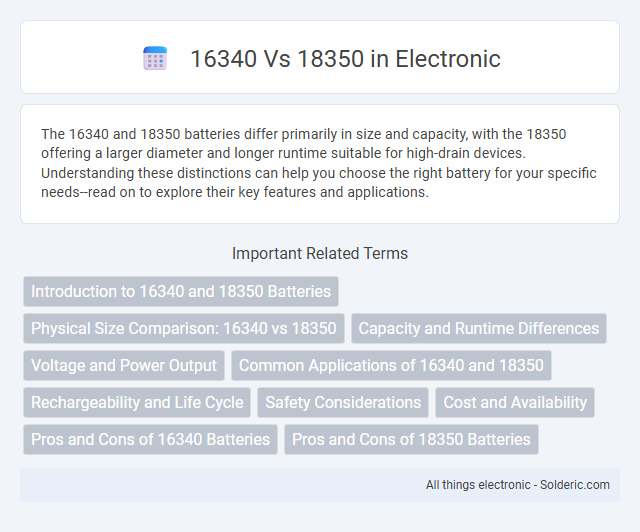The 16340 and 18350 batteries differ primarily in size and capacity, with the 18350 offering a larger diameter and longer runtime suitable for high-drain devices. Understanding these distinctions can help you choose the right battery for your specific needs--read on to explore their key features and applications.
Comparison Table
| Feature | 16340 Battery | 18350 Battery |
|---|---|---|
| Size (Diameter x Length) | 16mm x 34mm | 18mm x 35mm |
| Capacity (mAh) | 600 - 1200 mAh | 700 - 1200 mAh |
| Voltage | 3.6V - 3.7V | 3.6V - 3.7V |
| Common Usage | Flashlights, vape pens, cameras | Flashlights, vape mods, portable electronics |
| Rechargeable | Yes (Li-ion) | Yes (Li-ion) |
| Weight | Approx 14-18 grams | Approx 20-25 grams |
Introduction to 16340 and 18350 Batteries
16340 and 18350 batteries are popular rechargeable lithium-ion cells commonly used in compact electronic devices like flashlights, vape mods, and portable gadgets. The 16340 battery typically measures 16mm in diameter and 34mm in length, while the 18350 battery is slightly larger at 18mm in diameter and 35mm in length, offering different capacity and power outputs. Knowing these specifications helps you select the right battery for optimal performance and device compatibility.
Physical Size Comparison: 16340 vs 18350
The 16340 battery measures approximately 16mm in diameter and 34mm in length, making it slightly narrower but longer than the 18350, which is about 18mm in diameter and 35mm in length. This size difference affects their compatibility with devices, as the 18350 offers more capacity but may not fit in smaller battery compartments designed for 16340 cells. Choosing between the two depends largely on the physical constraints of the device and required battery capacity.
Capacity and Runtime Differences
The 16340 battery typically offers a capacity of around 700-900mAh, resulting in shorter runtime compared to the 18350 battery, which usually provides higher capacity ranging between 1200-1500mAh. This increased capacity in the 18350 enables longer device usage before needing a recharge, making it more suitable for high-drain applications. Users prioritizing extended runtime and better energy storage benefit significantly from choosing the 18350 over the 16340 battery size.
Voltage and Power Output
The 16340 battery typically operates at a nominal voltage of 3.7 volts with a capacity ranging from 600mAh to 1200mAh, delivering moderate power output suitable for compact devices. The 18350 battery also has a nominal voltage of 3.7 volts but generally offers higher capacity, ranging from 700mAh to 1200mAh, resulting in enhanced power output and longer runtime. Both batteries provide similar voltage levels, but the 18350's larger size enables increased power output and energy delivery.
Common Applications of 16340 and 18350
16340 and 18350 batteries are frequently used in compact electronic devices where space is limited, such as flashlights, vaporizers, and portable medical equipment. The 16340, also known as CR123A, is favored for high-drain devices requiring reliable power and longer runtime, while the slightly larger 18350 offers increased capacity, making it suitable for advanced vaping mods and high-performance flashlights. When selecting a battery, consider your device's size constraints and power needs to ensure optimal performance and safety.
Rechargeability and Life Cycle
The 16340 battery offers a rechargeability cycle typically ranging between 300 to 500 charges, while the 18350 battery generally supports around 500 to 700 recharge cycles, reflecting its enhanced durability. Both batteries utilize lithium-ion chemistry, but the larger 18350 tends to maintain capacity and voltage stability over more extensive usage periods. As a result, users seeking extended life cycles and reliable rechargeability often prefer the 18350 for high-drain applications.
Safety Considerations
When comparing the 16340 and 18350 batteries, safety considerations center on their size, capacity, and application suitability. The 18350 battery generally offers a higher capacity and voltage, but its compact design demands careful handling to prevent overheating or damage in high-drain devices. Ensure your device supports the specific battery size and chemistry to maintain optimal safety and prevent risks such as leakage or explosion.
Cost and Availability
The 16340 battery typically costs more than the 18350 due to its higher capacity and premium materials, impacting budget-sensitive applications. Availability varies by region, with the 18350 being more widely stocked in general retail stores thanks to its longer market presence and common use in smaller devices. Buyers seeking affordability and ease of purchase often prefer the 18350, while users prioritizing performance may accept higher costs for the 16340.
Pros and Cons of 16340 Batteries
16340 batteries offer higher voltage output, usually 3.7V, compared to the 3.0V of 18350 cells, delivering more consistent power for your devices. Their compact size is advantageous for lightweight gadgets, but they generally have lower capacity and shorter runtime than 18350 batteries. You benefit from quicker recharge cycles with 16340 batteries, though they may require more frequent replacements in high-drain applications.
Pros and Cons of 18350 Batteries
18350 batteries offer a compact size and higher capacity compared to 16340 batteries, making them ideal for devices requiring longer runtime without frequent recharging. Their larger size, however, makes them less portable and compatible with fewer devices than the smaller 16340. While 18350 batteries typically provide better current output and thermal management, they may be more expensive and heavier, impacting overall device ergonomics.
16340 vs 18350 Infographic

 solderic.com
solderic.com